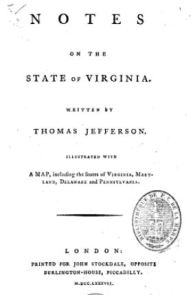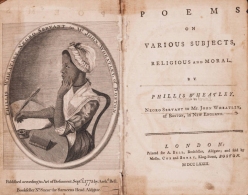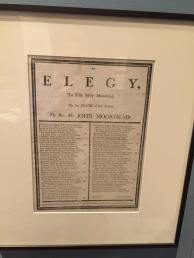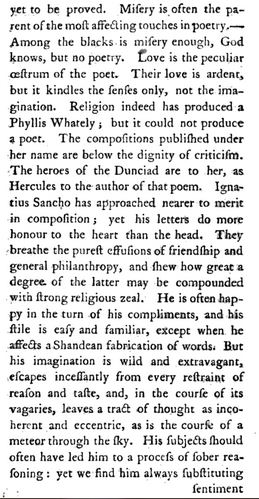 Happy Birthday, Thomas Jefferson!
Happy Birthday, Thomas Jefferson!
It is the anniversary of Thomas Jefferson’s birthday today! Happy birthday, Thomas! (Note: it was the anniversary of Jefferson’s birthday when this post originally appeared.) We at PALS love to pair texts together; to mark today, a tweet advocating for a text pairing of Jefferson and Phillis Wheatley seem appropriate. Instead, I decided to write a quick post about pairing Jefferson and Wheatley because using such a pairing in a class, especially in the survey, often brings with it several difficulties.
Wheatley and Jefferson: A Natural Pairing in the Classroom
Pairing Wheatley and Jefferson together on a single day is class seems natural because many anthologies of American literature encourage such pairings. The Norton Anthology of American Literature includes poetry by Wheatley along with writings by Jefferson, specifically his Query XIV from Notes on the State of Virginia, which famously criticizes Wheatley’s poetic abilities. Wheatley and Jefferson pairings are often reinforced by anthologies that include sections on the drafting of the Declaration of Independence, which often draw attention to the differing attitudes towards slavery in the draft verses the final version.

Given the selections anthologies include on Wheatley and Jefferson there is a tendency to pack several texts into one class period. Packing a class period with short texts is a natural response since we are often under pressure to cover a lot of material over a semester. Since we’re provided the option to look at a few poems and an excerpt from a book, we might find ourselves inclined to stuff a lot of material into class. Again, it makes sense just in terms of planning. Students have been diligently reading though the early part of the semester, slogging through dense and difficult texts, and it makes sense to incorporate a day without heavy readings. A break in reading is good for the students and good for the instructor. Pairing Jefferson and Wheatley also seems natural because surely the texts will teach themselves. Students will be so taken by the topics at stake—race, slavery, and gender—that they will be caught up with an unbridled desire to drive class discussion with comments, questions, and debate.
It’s a Trap!

It was a disaster the first time I paired Wheatley and Jefferson.
I can still see myself—in a weird sort of out of body way—at the end of the class. I knew it was a disaster. The students knew it, too. None of the material was covered in sufficient depth. The students were not left with a sense of Jefferson as a complex human being. Jefferson was a hypocrite and villain. We didn’t cover the poetry of Wheatley in enough depth, either. However, my experience taught me a lot for the next time that I taught Wheatley and Jefferson. My experience also taught me that it is okay not to pair Jefferson and Wheatley.
Fight the Urge to Listen to the Anthology
Pairing Wheatley and Jefferson together means fitting them together in a larger narrative of American history along with the legacy of race and slavery in the United States. Pair Wheatley and Jefferson together if the thematic thrust of the class supports such a pairing. I taught Wheatley this semester, but I didn’t include Jefferson. The decision made sense because the class, designed as a writing class, wasn’t building along with the specific context that would help students unpack the nuances of a literary coupling between Jefferson and Wheatley. In short, don’t hesitate to not pair a text in some cases. That is okay.

Don’t be deceived by length or the easy approach. “On Being Brought From Africa to America” is short. However, the length of the poem is deceptive. Wheatley’s most famous poem can be covered in an entire class period. The poem deserves that level of attention. However, given Jefferson’s comments on poetry, artistry, and race, it makes sense to pair his comments with one of Wheatley’s poems that better illustrate her command of the neoclassical style, such as “On Imagination.” Of course, this means setting up of the neoclassical tradition and how Wheatley performed in that role as a poet. The many facets of Wheatley as a poet demands attention—and that demand means giving sufficient class time to help students develop an understanding of Wheatley as a poet.

First and second year students are likely unfamiliar with narratives that push against the traditional heroic and unquestioned depictions of the founders of the United States, especially in the case of Jefferson. Given the power and authority of Jefferson, it can be easy for students to buy into his criticisms of Wheatley’s lack of virtuosity as a poet. The nature of Jefferson’s criticisms of Wheatley means that it is imperative that students have the time and exposure to understand the formal elements of Wheatley’s poetry. Understanding Wheatley means highlighting her poetry in one or two days devoted to her own writings.
In short, it is okay to fight the anthology and the urge to pair texts. Yes, do pair Wheatley and Jefferson, but take the time needed to do so. Wheatley, Jefferson, and students deserve the time to have the full complexity of the issues at stake developed in meaningful ways.
Note: I offer further thoughts on Jefferson and Wheatley and the importance of sharing the good and bad over on my own blog. You can read more about #teachingfails in this special PALS roundtable.
3 thoughts on “Teaching Jefferson & Wheatley”